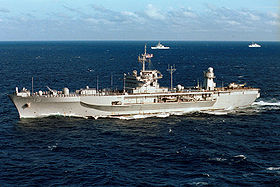Blue Ridge class
 USS Blue Ridge (LCC-19) |
|
| Overview | |
|---|---|
| Type | Command ship |
| units | Blue Ridge , Mount Whitney |
| 1. Period of service |
|
| period of service |
since 1970 |
| Technical specifications | |
| displacement |
19,290 ts |
| length |
189 m |
| width |
33 m |
| Draft |
8.2 m |
| crew |
40 officers, 680 men, |
| drive |
2 boilers, a geared turbine |
| speed |
21.5 knots |
| Range |
13,000 nautical miles |
| Armament |
1971
from 1974
current
|
The Blue Ridge class is a class of two amphibious warfare command ships for the United States Navy .
history
The ships of the Blue Ridge class were planned at the beginning of the sixties to replace the outdated command ships, some of which came from the Second World War. In 1963 the construction contract for the first ship was given, two more were to follow, but in 1968 the construction contract for the third ship was canceled. The USS Blue Ridge was built at the Philadelphia Naval Shipyard and launched in 1969, and entered service the following year. Her sister ship, Mount Whitney , was built at Newport News Shipbuilding and later joined the US Navy in 1971. The shipyard cost was about $ 36 million and the total cost of the ships was about $ 75 million per unit.
The Blue Ridge was assigned to the Pacific Fleet and has served as the flagship of the 7th US Fleet since 1979 . The Mount Whitney was used in the Atlantic and has been the flagship of the 6th US fleet since 2005 .
technology
Hull and drive
The hull of the Blue Ridge class is based on the amphibious assault ships of the Iwo Jima class . The hull was lengthened slightly to 189 meters compared to this, the width of the hull at the waterline is 25.3 meters. The deck has a maximum width of 33 meters. The drive system consists of two oil-fired steam boilers that feed a single geared turbine. This delivers its 22,000 hp output to a single shaft. The range is 13,000 nautical miles at 16 knots , the maximum speed is 21.5 knots. Wide side decks were attached on both sides to accommodate side boats and landing boats . The ships have a large helipad on the aft deck, and there are numerous antennas and radar systems on the upper deck. Amidships is the bridge structure with the Mack and the main radar systems, behind it a single free-standing electronic mast.
Furnishing
When they were commissioned, the ships were originally armed with two 3-inch twin guns on the foredeck, in 1974 two Sea Sparrow starters were installed aft of the bridge superstructure. The fire control of the 3-inch guns was taken over by two Mk.-56 fire control systems, the anti-aircraft missiles were controlled by two Mk.-115 systems. Two Phalanx CIWS have been on board for close-range defense since the 1980s ; the guns and the guided missile launchers were removed along with the fire control systems in 1992.
The ships have extensive electronic equipment, in addition to the radar systems ( AN / SPS-10 , AN / SPS-40 , AN / SPS-48 ) there are extensive communication and data processing systems that support the embarked staff in their work. All rooms below deck are air-conditioned, the ships also have photo laboratories and documentation facilities.
Web links
- Navy Fact File: Amphibious Command Ships - LCC (English)
- Blue Ridge class at globalsecurity.org (English)
Footnotes
- ↑ a b Stefan Terzibaschitsch : Sea power USA . Bechtermünz Verlag, Augsburg 1997, ISBN 3-86047-576-2 . P. 551
- ^ Stefan Terzibaschitsch: Sea power USA . Bechtermünz Verlag, Augsburg 1997, ISBN 3-86047-576-2 . P. 552
- ^ Stefan Terzibaschitsch: Sea power USA . Bechtermünz Verlag, Augsburg 1997, ISBN 3-86047-576-2 . P. 550